Submitted by Berrin Chatzi Chousein
Whatever happened to student housing?
Turkey Architecture News - Nov 10, 2013 - 14:21 6219 views
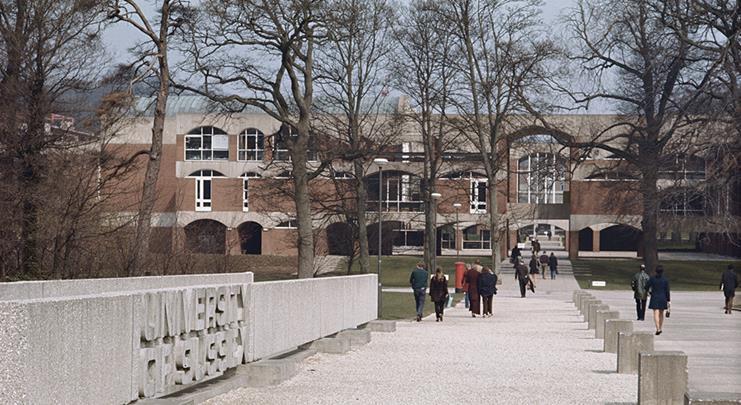
With university accommodation now defined by the developers’ desire to cram students in as densely as possible, high-quality design may be too much to ask, says Owen Hatherley
With luck, Stephen George & Partners’ Caledonian Road student housing will represent some sort of nadir, a point where the astonishing poverty of student housing reveals itself to all but the most blithely Gradgrindian.
There is justified outrage that something so transparently barbaric can be perpetuated on any social group, and long overdue calls for the imposition of standards and regulation.
Yet there is little attention on how this managed to happen specifically to students. Why them, and why now? How did this toxic combination of ruthlessly stripped-down existenzminimum, system-building and stunning formal ineptitude come to be the norm for student housing? What has happened to universities themselves to make them its sponsors and abettors? And has the obvious dreadfulness of student housing, rising in the centres of every town in the UK, had much effect on the architecture of universities themselves?
Until the 1990s universities generally came in three forms, in terms of their architecture and urbanism: the enclosed, insular world of Oxbridge; the red brick universities of the midlands and the north; and the plate-glass universities of the 1960s, like Sussex, East Anglia and Essex. What came next was the renaming of polytechnics all over the UK as universities.
In the early 1990s polys, like art colleges, tended to be more urban, more “municipal”, less enclosed in their planning — hence the place right in the heart of the city held by such ex-polys as Sheffield Hallam, London Metropolitan or the University of Portsmouth. So that’s four distinct urban and architectural creatures, most of which have developed in different directions since.
But the biggest impact of all was in the way the last government at once expanded higher education and marketised it. Rather than the large new influx of students into those four very different kinds of campuses being managed by the universities themselves, in the form of purpose-built and publicly funded halls, the task was turned over to developers. These new buildings would differ wildly in quality, the only constant being near-universally appalling housing.
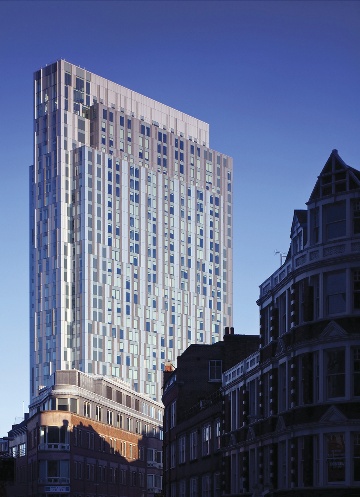
Source: View Pictures/UIG//Nido Spitalfields (2010) rises to 112m and houses more than 1,200 students.
This is mostly expensive — divided into very expensive and slightly less so — but you wouldn’t know from the architecture. The high end is represented by the developers Nido, as at their shiny TP Bennett-designed skyscraper in Spitalfields, a smaller part of the City of London’s “cluster”; the low-end is supplied by Unite, enthusiastic system-builders who have mauled the skylines of the north with high-density, high-security, low-quality tower complexes like Sky Plaza in Leeds and Grand Central in Liverpool.
Another instructive aspect is the sheer irrelevance of pedigree and prestige to the eventual build quality — UCL, Leicester, even Oxford, all have blithely sponsored similarly atrocious student housing. Even the privileged are given housing of such grimness that it would have been prohibited by 19th century regulations. Like temping and interning, it is justified by the logic of brevity — a mere 10 or so months in such conditions apparently excuses their poverty.Those of us who have to look at the buildings from outside have no such dispensation.
The introduction of tuition fees and the abolition of grants had another direct architectural result: the need for “icons” to impress visiting potential students and their parents in order to part them from their cash; and, sometimes, the ruin of those icons, as the recent university reforms — sucking money from the ex-polys and humanities departments and trebling fees — began to have an effect.
The most symptomatic of the icons is probably Daniel Libeskind’s students’ union for London Metropolitan University. This was one of the first instances where it became crystal clear that Libeskind’s formal repertoire of Caspar David Friedrich crashing and banging was not, actually, about war or the Holocaust. All of its vaulting, aggressive gestures were designed to “put London Met on the map”, and to give an image of fearless modernity with, however, little of consequence to actually do.
It is an especially striking contrast with Brady Mallalieu’s architecture faculty, part of the same college and at the other end of Holloway Road, a hard building meant to be used and bashed about by the students. Libeskind’s, on the other hand, strains and gesticulates but is too delicate to be used for much more than a café. There are similar buildings in universities all over the country, though they are not all quite so melodramatic as this.
It’s not easy being iconic
A face-off at the University of Sheffield illustrates the point especially well. The university is an interesting stylistic mess, and like Sheffield itself, there is little to pull it together but the attempts made at doing so during the 1960s — here in the form of Gollins Melvin Ward’s well-loved work, treated rather better than the council’s own, equally important legacy.
But a short walk from here shows two buildings up against each other — Jessop West, by Sauerbruch Hutton, and the Edwardian, neo-Tudor former Jessop Hospital, designed by John Webster. The latter is gutted and awaiting the bulldozer, after the university managed to delist it with the assistance of Eric Pickles, in favour of a confused farrago of a design by RMJM. Its alleged necessity suggests that Jessop West has not served its purpose as the icon.
Its bright, stripey barcode facade is relatively well made, but on a recent visit one tutor showed me around the interior, a rather lovely wood-clad space of interlocking levels and large “social spaces”. These were apparently almost entirely unused, and the classrooms too small to actually teach in – something that happened instead in the knocked-around 1960s buildings nearby. Its only function, he insisted, was to impress parents.
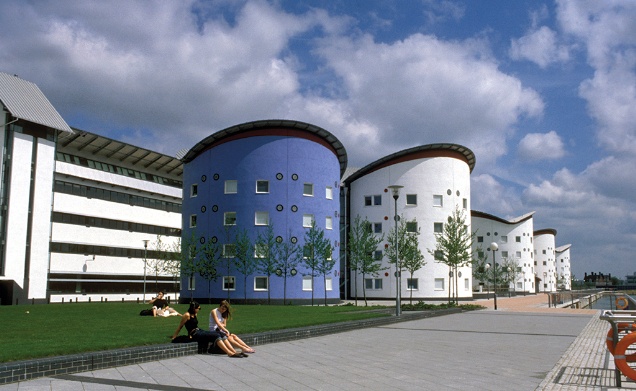
Source: photofusion/UIG/Getty Images//Both cohesive and alien: Cullinan Studio’s campus for the University of East London (1999).
Complete campuses have been a rarity in this era – the new places that have come into being are largely the result of mergers, or of the most successful Russell Group universities deciding they require some lebensraum.
A notorious example of the latter is the Jubilee Campus in Nottingham, on the site of the former Raleigh Bicycles factory – a low-wattage but careful and coherent Scando-high-tech campus designed by Hopkins, suddenly dive-bombed by Make’s series of screaming, awkward clichés.
Rather better is the new campus of an ex-poly, the University of East London, in the Royal Docks — where, despite an undercurrent of cheapness and eagerness to please, Cullinan managed to create a space both cohesive and alien, particularly in the form of the Teletubby-esque coloured drums that are one of the very few recent attempts to actually plan student accommodation, rather than just leaving it to the developers.
It would be difficult to give a snappy and faintly snobbish name, like red brick or plate-glass, to this generation.
Slatted-wood universities? Atrial universities? Strangely, for structures of the 1960s, the plate-glass universities have often survived well, with the most famous examples listed, protected and relatively well scrubbed. They have an out-of-time and out-of-space quality. Here, money and time allowed a leisured sprawl of buildings into landscape, the on-site housing implying discrete and self-contained collegiate communities that can sometimes look desolate in their isolation from any real urban context, and sometimes inspiring in their total, fearless break with the past.
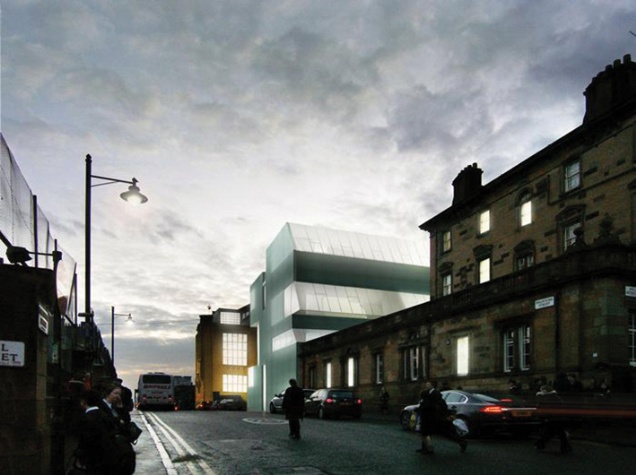
Steven Holl’s new addition to the Glasgow School of Art.
The unlisted and more uneasy exceptions include Brunel, Essex and Southampton, where major parts of campuses by (respectively) Sheppard Robson, Architects Co-Partnership and Basil Spence are facing attrition. Brunel, out in the Middlesex wastes, houses the Lecture Centre, filmed by Kubrick
in A Clockwork Orange as the Ludovico Institute, a piece of brutalism at its most Melnikovian: a burst of compacted energy. Newer buildings nearby visibly shrink from it.
Southampton, meanwhile, is somewhere between UEA’s near-total isolation and the urbanity of the polys and red bricks, rolling out over a sloping site between Southampton Common and a large, banal interwar council estate. It isn’t as heralded as Sussex, but it has some of Spence’s finest moments, long curtain-walled blocks that ride the hills like Mies houses of the 1920s. Much of this is under threat, and the new buildings, mostly by Wilson Mason, are impeccably neat and well-mannered but spurn the earlier attempt to create a new landscape.
It is rare to see an architect actually work with the structures of a 1960s campus, and one of the few examples is actually the work of an artist rather than an architect — the series of disconnected steps that occupied the plaza in front of the arts buildings of Percy Thomas’s University of Aberystwyth.
The strange placelessness that resulted went all the way into Giorgio de Chirico territory.
Architecture for art’s sake
Art schools seldom even exist now – like the polys, they have been eaten up, their obvious inheritors being amalgamated mega-colleges like the University of the Arts London. The Central Saint Martins campus at King’s Cross is an expression of this: a cold, sweeping atrial space, part of a new developers’ “quarter”, albeit an unusually well-designed one.
I studied at Goldsmiths College in south-east London, a neo-Georgian grid by Blomfield. The fine art department mainly had its classes in “the huts”, a series of prefabs in an obscure corner — the success of its students in the early 1990s seemed to confirm Cedric Price’s contention that the best teaching took place in barely-permanent, improvised spaces. Moving to a purpose-built Alsop-designed “icon”, then, was interesting given the architect’s alleged grounding in Price’s work. The building in question is one of Alsop’s most straightforward, a curtain-walled grid with only a three-dimensional scribble at the top to remind us it’s iconic.
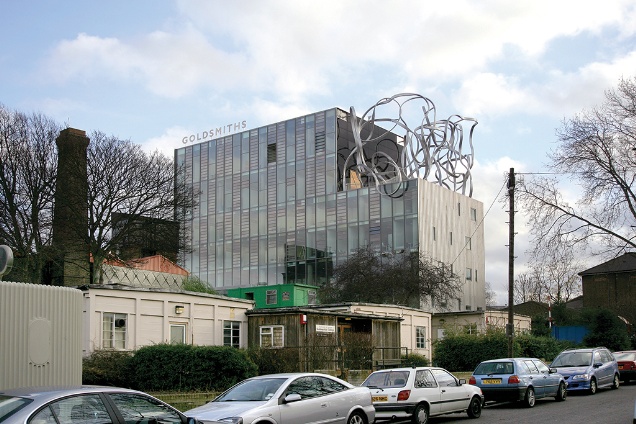
Source: Morley Von Sternberg//Alsop Architects’ Ben Pimlott Building for Goldsmiths (2005).
One of the few art schools that is still unamalgamated, that still has the same close, embedded relationship with its urban surroundings, is the Glasgow School of Art. Even with the addition of Keppie’s Newbery Tower it was a discrete presence in the city. Steven Holl’s new building just opposite does not defer to Mackintosh, as the brutalist tower did, rising up and away into its own space as if to disclaim any attempt to compete. Instead, it addresses the original school directly. Yet it appears refreshingly uninterested in either high-security or flash, the twin obsessions of the last two decades.
If it does turn out to be worthy of its place in the middle of a dense, fascinating inner city, this will be as an exception. In the delisting of Sheffield’s Jessop building, or the construction of Carbuncle Cup-nominated student flats in London and Oxford, it was initially local councillors, and then when they gave way, campaigners, who found themselves the defenders of architecture and urbanity — this time against the universities. Their concerns evidently lie elsewhere. But what of the students?
EDUCATION’S HIGHER GOALS
With its £21.5 million O’Donnell & Tuomey-designed student centre set to open in January, the London School of Economics is already planning what is set to be its largest ever capital project: the £90 million Global Centre for Social Sciences, writes Ellis Woodman.
And yet among the UK’s higher education institutions, such ambitions are by no means exceptional. The University of Swansea recently broke ground on a £250 million science and innovation campus planned by Porphyrios Associates, while the University of Ulster is looking to spend a similar figure on a multi-department building designed by Feilden Clegg Bradley for a site in central Belfast. Even these figures are dwarfed by the £1 billion that the University of Cambridge is investing in its north-west Cambridge development.
The fact that the coming decade looks certain to be a period of significant expansion for many UK universities – and particularly for the second-tier institutions of the Russell Group – is attributable to two principal causes. The first is a recent relaxation of restrictions that in the past have limited universities’ ability to borrow capital.
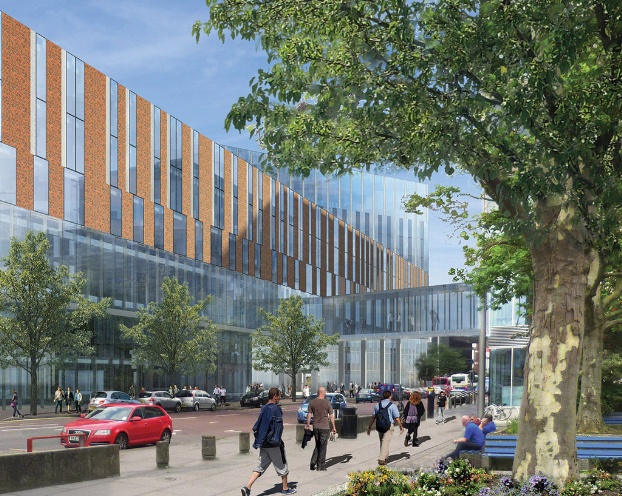
Feilden Clegg Bradley’s plans for the University of Ulster.
There is certainly no shortage of willing lenders: in light of the current state of the markets, large institutional investors such as pension funds have come to view university building as one of the few safe havens for their capital.
The other cause is the seemingly inexorable rise in student numbers, fuelled in large part by increased applications from overseas candidates. Factor in the need for universities to bring their existing building stock up to current standards of environmental performance and it is clear why higher education has recently proved to be one of the construction industry’s more resilient sectors.
As the stellar shortlist of practices currently competing for the new LSE project might suggest, the UK’s universities are also coming to a new awareness of the role that architecture can play in establishing a brand that might appeal to prospective students.
One of the more surprising instances of this phenomenon was the University of Durham’s recent appoint-ment of Daniel Libeskind to design its new physics department. For an institution that had built nothing of architectural consequence for decades this represented something of a Damascene conversion. But given the current competition for students it is a safe bet that, in the coming years, plenty of other higher education institutions in the UK will be announcing similarly unlikely appointments.
> via bdonline.co.uk
